Letters from Lodi
An insightful and objective look at viticulture and winemaking from the Lodi
Appellation and the growers and vintners behind these crafts. Told from the
perspective of multi-award winning wine journalist, Randy Caparoso.
Vintage images of early 1900s when Lodi transformed from a Wild West town into a respectable City

Lodi "Tokay Princess" postcard image from 1907 (left) next to a modern-day Tokay grape-bearing lass (right)
Lodi during the latter half of the 1800s, writes local historian Toni Christman in Our Time to Shine (2012), was "an unruly child, gathering strangers from all walks of life migrating from (nearby) Lockeford, Stockton, Sacramento in addition to other existing nearby settlements. Lodi was sometimes referred to as a ‘rum-guzzling’ town with young boys on the road to hell.”

1907 postcard commemorating Lodi's historic Mission Arch erected for Lodi's Tokay Carnival (September 19-21, 1907), showing the City's still-unpaved streets and Central California Traction Company's electric streetcar line going down Sacramento St. (connecting Stockton with Sacramento)
In his Historical Study of the Public Schools of Lodi California, Ralph Morton Wetmore recounts one 1886 incident taking place in the Salem District schoolhouse (at the time located just north of E. Lodi Ave. and east of S. Stockton St.)...

Colorized early 1880s view of Lodi from E. Pine St. before the Tokay Arch was erected, showing the Lodi Hotel to the left, opposite the north-west corner where the Bank of Lodi would be founded (in 1888)
Wetmore's account illustrates those rambunctious times:
The school was often used as a community meeting place. One of the groups using the building was a well-known lodge of the time known as The Independent Order of Good Templars. It is reported that one evening while the Order was in session some unprincipled character entered the anteroom and emptied the entire contents of a whiskey bottle into the drinking water bucket. It was not long after being discovered and soon there was a waiting line at the water bucket. All was well until a conscientious sister discovered the reason for the sudden thirst. An uproar followed and the incident came near disrupting the lodge.

1910 photo of Salem District schoolhouse located north of E. Lodi Ave. east of S. Stockton St., originally built in 1886 and phased out and torn down in 1938
As with most rural American towns, "respectability" for Lodi came incrementally. Some of the community leaders strongly felt that incorporating into a City would help. A motion in 1904, however, was decisively voted down, primarily due to the opposition of saloon owners and other businesses. But on November 27, 1906, an election was held by the Lodi citizenry (population 2,000 at that time), and the proposal was passed by a 2 to 1 margin. What turned the tide, writes Lucy Reller and Ralph Lea in the Lodi Historian (Lodi Historical Society) newsletter, was “the opposition of the saloon keepers had a reverse effect and increased the desire of church people and the average citizen to incorporate.”

The Lodi Hotel 1900, which stood at the southwest corner of W. Pine and Sacramento Streets until torn down in 1912, becoming the second site of the Bank of Lodi (the building now housing Graffigna Fruit Co.)
On December 3, 1906, the San Joaquin County Board of Supervisors decreed that Lodi was duly incorporated as a municipal corporation, which became official three days later upon filing with the California Secretary of State's Office. Finally, writes Christman puts it, Lodi's “citizens were well on their way to respectability.”
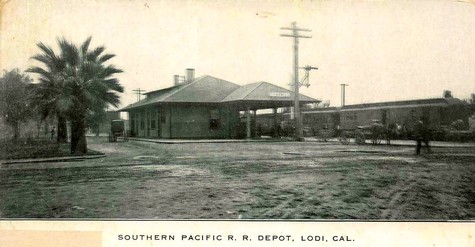
The Southern Pacific Railroad depot in 1910, located on S. Sacramento St. just a few feet from the Lodi Hotel
So let’s paint a picture of this once-forsaken town, starting in 1846 when the first settlers of European descent arrived in the area we know as Lodi. The earliest arrivals settled on the name “Mokelumne,” for the Mokelumne River winding through the area on the way to the Delta from the Sierra Nevada. Mokul is a corruption of the native Plains Miwok tribe’s word for the river; one referring to “people of.” By 1846 the Miwok population had all but disappeared, particularly following a calamitous plague ravaging San Joaquin Valley in 1832.
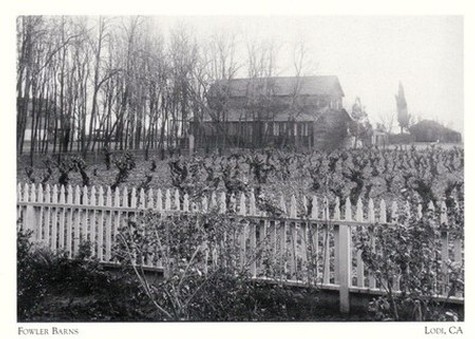
1907 postcard depicting Fowler Barns, a Lodi farm planted to head trained Flame Tokay producing grapes that had by then become Lodi's leading contributor to the local economy
In 1869 a group of the area’s original landowning settlers persuaded Central Pacific Railroad to make Mokelumne one of the stops between Stockton and Sacramento. The town's first business buildings, at the corner of present-day Sacramento and Pine Streets — where the landmark Lodi Arch would later be erected in 1907 — were built alongside the railway station, a site chosen because it sits on slightly higher ground, less prone to the Mokelumne River's frequent (at the time) flooding.

The early 1900s colorized postcard showing Woodbridge irrigation ditch bringing cool Sierra Nevada water from the Mokelumne River to Lodi vineyards
But aside from the obvious difficulty of pronouncing Mokelumne, locals knew another name eventually needed to be chosen because the town was often confused with nearby communities with similar names — particularly Mokelumne Hill and Mokelumne City — which continuously hampered mail delivery and delayed shipments of goods and supplies.
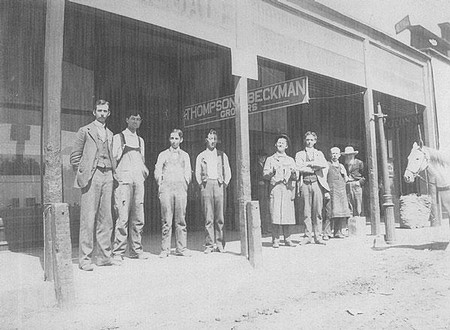
Early 1900s photo of owners, staff, and delivery horse in front of Downtown Lodi's Thompson & Beckman Grocers
But why the name “Lodi?” According to Christman, one opinion “holds that it honored a famous trotting horse bred in Woodland, California, raced in Sacramento. Another theory says settlers from Lodi, Illinois promoted the choice. A third possibility recalls the Italian site of Napoleon’s first victory against the Austrians. Lodi in Italian means beautiful. Whatever reason you choose, in 1874 it became Lodi.”

Around 1900, the Lodi home (at the corner of N. School and W. Elm Streets) of leading Lodi citizen Dr. Wilton Mason, showing off the City's very first horseless carriage (as automobiles were called in those days)
However, in the 1870s and 1880s, the newly christened Lodi was still a classic Western American town. Writes Christman:
In 1881, Lodi was considered wild, uncontrolled, and causing great distress to peaceful residents. Partiers patronized too many saloons spending too much money gambling on cards, or horse, dog, and turkey races. Then for lack of anything else, they threw their hard-earned dollars away on turtle races!

Enthusiastic crowd at 1900 Lodi baseball game pitting the Yosemite Club of Stockton against Woodbridge (image courtest of Bank of Stockton)
Inhabitants carried sports to extremes as a diversion from everyday life. On Sundays, and Holidays, especially July 4th, the business world would close its doors and shopping came to a standstill. Sacramento Street would come alive with bystanders, bettors, and spectators lined up taking pleasure in observing the horses and dog races. Well-attended baseball games against nearby towns provided additional Sunday wagering opportunities in both money and prizes. These wagering events were sometimes followed by a dance at Sacramento Street Park.
Dog racing was not always performed on a track using Greyhounds. In the early 1900s, participants picked a large field and then proceeded to turn their dogs loose on wild rabbits. The first dog to catch a rabbit won the race...

1915 photo of the bar in the newly opened Hotel Lodi (located on S. School at W. Pine St.), one of just a handful of "saloons" licensed by the City in those days, influenced by a prevailing temperance movement
Authorities attempted to curb illegal gambling practices in Lodi. The Club Saloon in 1902 had the nickel-in-the-slot machine, only to meet its fatal fate. The three slot machines (one-armed bandits) in Lodi Hotel in 1903 were given a fond goodbye with their faces turned facing the wall. In the refined Chinatown community, income needed to pay debts was instead being lost on lottery tickets.

1900 photo of the Lodi Outlaws baseball club, led by manager Josephus Friedberger (center)
Then there were animals — not wild ones, just an overwhelming domestic population. Writes Reller and Lea, it wasn’t until 1895 that the County Board finally appointed a “Poundmaster” to “pick up dogs, pigs, horses, and cattle, etc. from the streets of Lodi during the day, but at night most people opened their gates to allow animals to eat grass and Lodi looked like a country fair.”
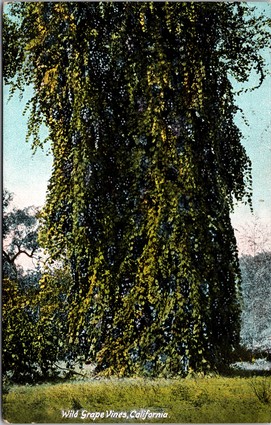
1908 colorized postcard depicting "Wild Grape Vines" growing in Lodi — a more common sight in the 1840s and 1850s, when the region's first settlers of European descent staked their properties along the Mokelumne River
Although Lodi’s population was never to grow at the rate of more urban communities like Sacramento to the north and Stockton to the south, it quickly became renowned as an agricultural community. In 1876, according to Christman, “the world’s largest crop, 3.4 million bushels of the grain (wheat), was raised around the outskirts of Lodi.” When wheat and barley prices failed, local farmers turned to watermelons, and by the early 1890s Lodi had a new title as the “Watermelon Capital of the Country.”
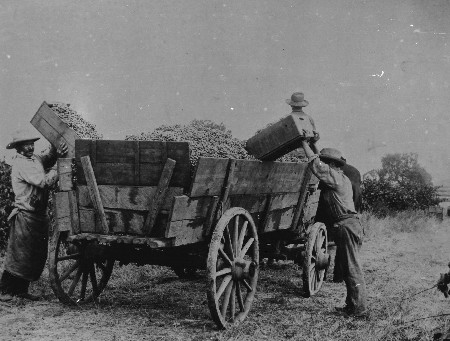
Early 1900s photos of Lodi wine grape harvest
It would be grapes, of course, that would eventually emerge as the region’s most enduring crop. Christman tells us, “Swiss immigrant Mr. Magley was said to have planted the first vineyard in 1848 on Turner Road. The projected wealth from this new crop beckoned relatives and acquaintances in the Dakotas, who hastened to this land of plenty.” By 1905, Lodi was known worldwide as the “heartland of the delectable Flame Tokay grape,” and by 1907 Lodi was shipping out over $10 million (over $240 million by today's currency) in grapes for the table or for wine production.

1910 postcard depicting Flame Tokay grape packers (primarily women) in Lodi shed
Most of Lodi’s new arrivals between the 1890s and 1920s were families of German descent. Aside from mud-holed streets and the promising agricultural opportunities, what they found in their new home was less than acceptable from a social standpoint.
Writes Christman, “Race tracks plus about 14 saloons far outnumbered its four Churches. Abstemious Germans were appalled by a main street lined with bars sporting brass railings, spittoons, scantily dressed fast ladies of the night, loud piano music, and mugs of beer for five cents. Worse, those establishments were open all evening; including, heaven forbid, Sunday! Because there were too few churches for the population, religious services were often held in saloons.”

1913 postcard for Beckman, Welch, and Thompson Company, located in Downtown Lodi
Hence, in December 1906, when Lodi’s newly appointed Board of Trustees began to meet to establish order, new laws, and revenue sources, the following were among the first ordinances passed:
• Saloon licenses are $100 for three months, plus $12 for billiard tables.
• A quarterly fee of $50 for patent medicine sales using music to attract attendance (i.e. medicine shows).
• Other license fees; including $10 for real estate offices, $15 for hotels, and $3 for “storekeepers” or “traders.”
• No “trading” on Sundays.
• Saloons are open only from 6 AM to 12 PM and closed on Sundays.
• Saloon windows must be high enough to prevent youngsters from peering in.

1909 postcard depicting the palm-lined N. Sacramento St., just north of the Lodi Arch
• Minors possessing liquor must have a note from a parent.
• No gambling within City limits.
• Disposal of “filth, rubbish, offal, and slops,” plus a law prohibiting “swill carts” from leaking.
• No “animals at large on City streets.”
• Misdemeanor charges for “vulgar and abusive language in public,” “whistling in public halls,” and “singing in saloons.”
• A speed limit (for suddenly fashionable horseless carriages) of 8 miles per hour.
• Unlawful to leave horses unhitched.

The early 1900s colorized postcard showing off a shady W. Elm St. near the center of Downtown Lodi
Even more importantly, Lodi’s incorporation as a City and ability to levy and collect taxes would almost immediately lead to the establishment or improvements of essential services such as utilities (especially for gas, electricity, and water), waste and sewage disposal, fire hydrants and protection, and street paving (the first Downtown Lodi streets to be paved would be School and Pine in 1912).
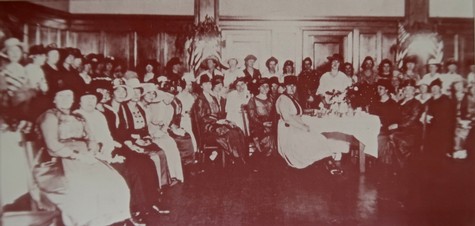
1919 luncheon and meeting of the Woman's Club of Lodi at Hotel Lodi
"Progress and betterment of Lodi" was also the stated goals of the Lodi Ladies Improvement Club, established in 1906 by 28 women determined to play a stronger role in civic improvement than what had previously been possible through their various church groups, local temperance, and anti-saloon movements, or through female chapters paralleling men's organizations such as the Masonic Lodge, Knights of Pythias and Odd Fellows.
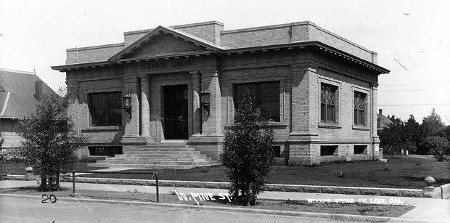
1910 photo of Lodi Carnegie Library shortly after it was opened, thanks to 25 years of cumulative effort by Lodi's women's groups
Even before Lodi became a City, it was Lodi's "pioneer ladies" (as the Lodi Historian newsletter describes them) who successfully raised the funds to found the Lodi Public Library and Free Reading Room — initiating this drive in 1885, which culminated in the opening of the Lodi Carnegie Library in 1910 (with the help of a $9,000 grant from the Carnegie Foundation).
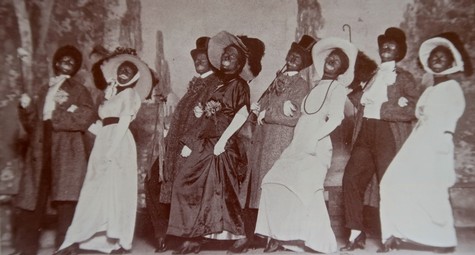
1914 Lodi Woman's Club "black face" performance of Merry Minstrel Maids at the Lodi Opera House
Among the other early projects driven by the Lodi Ladies Improvement Club were upgrades in schools, fire protection, streets and sidewalks, garbage collection, trees, and overall beautification of the rapidly growing City. In 1913, when membership had grown to 65, the civic-minded group's name was changed to the Woman's Club of Lodi.

1925 photo of Women's Club of Lodi building — at the time, the largest hall of its type in the City
Soon after, a Woman's Building Association Inc. was established (selling 10,000 shares at $5 apiece). A lot on E. Pine St. at Lee Ave. was purchased for $10 in gold; and by 1923, at 450 strong (each member pitching in another $5 in dues), the Women's Club of Lodi was able to open the doors of their own meeting place: an ornately columned, neoclassical style auditorium — at that time, the largest hall of its type in Lodi — which is still utilized by the organization today (the building itself enshrined in 1988 as National Register of Historic Places No. 88000555).

1915 postcard showing St. Anne's Church, the Lodi Catholic community's second church (built in 1913 and replaced in 1963)
During Lodi's first decade of the 1900s, the influx of a more pious populace led to the establishment of no less than a dozen new churches of various denominations; and “this rough ‘n ready settlement,” according to Christman, was steadily transformed into “a God-fearing town." There were catches, however, to this newfound godliness. Adds Christman, "By WWII, when Lodi’s population was approximately 8,000, nearly half were of German descent. The joke among these folks was: knock on any Lodi door and a relative will answer. In later years, the joke became: if you want to date someone, find out first if you are related!” To this day, in fact, vintners from longtime Lodi farming families will still tell you that.

1909 colorized postcard of an estate Lodi "Country home"
Finally, in a burst of civic pride, in 1907 the burgeoning City's rank and file mobilized to announce their presence to the rest of the entire world by organizing the Tokay Carnival — a 3-day celebration of the region’s supreme grape and Lodi’s economic “arrival,” symbolized by the Mission Style Lodi Arch that still stands today at Pine and Sacramento Streets (since 1980, National Register of Historic Places No. 931). For a detailed accounting of this landmark event (which was never to be repeated), please see our post on In 1907 Lodi celebrated grapes like no American city never-ever has.

1910 postcard hailing Lodi High School
As of 2020, where is the City of Lodi (population surpassing 66,000) now? We asked Lodi's former Mayor (twice over) and first Lodi Winegrape Commission Executive Director (1991-2011) Mark Chandler, who wrote:
The city is now governed by an elected City Council made up of 5 members. We elect a Mayor and Vice Mayor among ourselves, and direct staff (principally the City Manager) to carry out our decisions. The City Manager has an executive team comprised of the City Attorney, City Clerk, Planning Director, Public Works Director, Electric Utility Director, Police and Fire Chiefs, Parks and Rec Director, etc. The city employs about 380 employees; plus there are volunteer advisory boards and commissions that provide recommendations to the City Council regarding their issues.
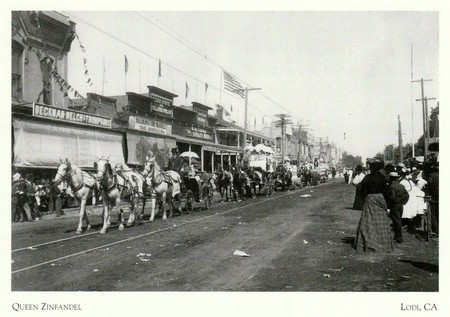
1907 postcard commemorating "Queen Zinfandel" in the Pine St. parade opening Lodi's historic three-day Tokay Festival
One of our most pressing issues today is economic development — increasing jobs and employment by bringing new companies to Lodi and growing the ones already here. We want to expand the hospitality infrastructure to leverage the success of the wine and tourism industries. Public safety (especially reducing crime, gang and/or drug-related) is a major concern, as well as public parks (rehabilitating Lodi Lake and other parks where deferred maintenance is diminishing the visitor experience). And of course, finance — such as dealing with the looming public employee retirement service obligations — is a major priority.

1907 promotional postcard inviting visitors to Lodi's "Grand Tokay Carnival"
If you ask most locals, Lodi has come a long way, but the future looks just as bright and wide-open as it did 115 years ago. As a wine region, recent accolades such as Wine Enthusiast's "Wine Region of the World" (2015) and "Winemaker of the Year" (2018) have put Lodi on the map; and accordingly, an ever-increasing visitor count (Visit Lodi!, the City's destination marketing arm, estimates about 2 million visitors a year) has steadily added more spit and shine to this community once known as a place where you wouldn't want to get "stuck."

1910 postcard extolling "Flaming Tokay... the Grape that made Lodi famous"